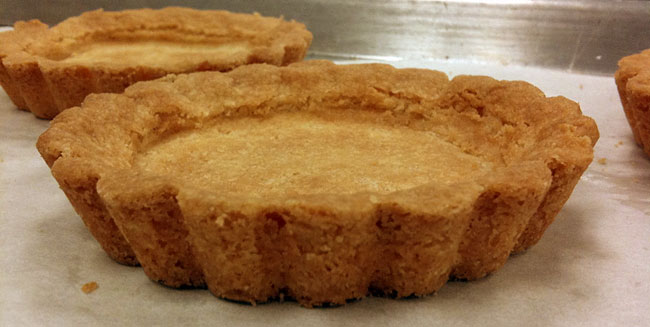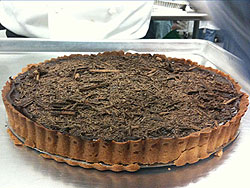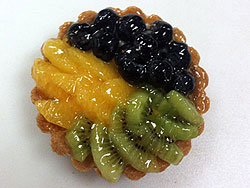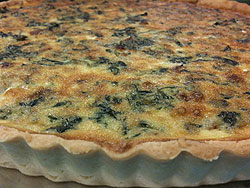This week in baking class we learned how to bake tarts and quiches. Both are basically the same type of pastry, only one is sweet and one is savory, with different fillings and garnishes. The fillings of tarts and quiches have infinite possibilities, pastry creme, frangipane, ganache, nuts, fruit etc.
We learned about the following types of tart doughs: savory, sweet and press in/cutout. All three use the creaming method. All but the press in/cutout require the dough to rest while chilled in order to keep the dough from shrinking when baked. Tart crusts are either fully or partially baked. Some tarts are returned to the oven with filling to be baked (like quiche).
Two main types of crust: Pate Brisee (savory dough) and Pate Sucree (sweet dough). Both use this method in its creation:
- Mix dry ingredients
- pulse in food processor with fat until course meal
- add liquids and pulse
- flatten to large disc and refrigerate (rest)
- Roll on floured surface to 1/8″
- With the dough wrapped around the rolling pin, gently place the dough on the tart pan, do not push it on the sharp edges. Using your fingers gently work your way around the inside of the pan pressing the dough into the inside bottom to a corners. Use a roll rolling pin across top to after setting the inside corners to cut off the excess dough.
Overfill the crusts, will cause leakage into the tart pan. Custard based fillings that require baking in tart should always be baked on a sheet pan and be lined with parchment paper for easier cleanup.
All purpose sugar dough (similar to sugar cookie dough) is another type of dough that can be used to create the crust. The method for creating this crust is as follows:
- Cream the butter and the sugar.
- Add the flour in 3 stages
- Refrigerate
- Fully bake tart shell
- Right after removal from the oven press down the dough in the tart form to eliminate puffiness of the crust.
We also covered some pastry techniques:
Ganache technique
- Use best chocolate you can afford (cheaper to get in bulk than bars)
- Cream with the highest fat content is best
- Chop chocolate in small pieces and put in a bowl
- pour cream over chocolate (no the other way around or it will separate)
- Stir until smooth (do not whisk) if hasn’t melted use a bain marie (water bath)
- Don’t make until you are ready to Use
- Cut ofter its cooled with a warmed knife, cleaning after each slice
Pastry cream:
- Tempering method: Bring milk and vanilla bean to a boil (whisking to stop burning). Pour about 1/3 of the heated milk and vanilla into the eggs (whisking the whole time) then whisk the rest of the milk mixture and pour the egg and milk into the remaining milk and vanilla whisking the whole time. Keeps the eggs from cooking. If using vanilla extract add it at the end.
- Use all stainless pan only with direct heat or the cream will change colors (reaction with the metal)
- Cover with plastic wrap on the surface of the pastry cream to cool (no skin)
- Creme Mousseline: 1/2 pastry cream and 1/2 whipped cream.
Heres what we made today:

 Chocolate Pecan Cajeta Tart
Chocolate Pecan Cajeta Tart Fresh Fruit Tart
Fresh Fruit Tart Spinach – Feta Quiche
Spinach – Feta Quiche
3 Comments
Chocolate pecan cajeta?? That sounds AMAZING. Do you have the recipe??
Jenne I should have a post up in the next day or two with the recipe and photos (I ended up making them outside of class last night).
You can see the recipe here: http://coombs.info/baking/2010/03/recipe/chocolate-pecan-cajeta-tart/